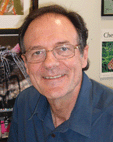DOI: 10.1039/C1CC90189C
(Profile)
Chem. Commun., 2012, 48, 1199-1200
Interview with Colin Raston
| ||||||
Do you remember what it felt like to publish your first ChemComm article?
This was an exciting time, as it was my first publication in organometallic chemistry (DOI = 10.1039/C39800001284) while a postdoctoral fellow with Professor Michael Lappert at the University of Sussex. I had changed fields from structural inorganic chemistry when I moved there from The University of Western Australia following a PhD and postdoctoral research under the supervision of Professor Allan White. It was a big challenge to get started in organometallic chemistry, more so given the highly air sensitive nature of the work. I hadn't had a Schlenk flask in my hand until moving to Sussex. Moving to another country was very challenging, but I knew what I wanted to do—to get into a new field that I was excited by, and to bring it back to Australia. Getting the first paper in the new field in ChemComm was a major achievement—I remember it well.How has your research evolved from your first to your most recent article?
In retrospect, changing fields in moving to Sussex laid the foundation for developing my research fields again, into main group chemistry and, in more recent years, into supramolecular and green chemistry, and nanoscience and process intensification. The most recent paper (DOI = 10.1039/C1CC13038B) essentially brings together all of these and the earlier structural chemistry, covering the inclusion of hydrogen and solvent molecules in self assembled molecular capsules which are formed under intense shear in thin films over a spinning disc—and involving molecular simulations.What do you like most about publishing in ChemComm?
It's a premium journal in the chemical sciences, which is internationally recognised in reporting new advances in the field, as a publication of a leading chemical society. Why wouldn't you want to be part of the action? The refereeing is usually complete in a few weeks, and the editorial process is streamlined, with great assistance in getting the package online as an advanced article. Publishing in colour without cost and the need for justification is very attractive, as is the healthy competition to secure the very popular front cover.What aspect of your research are you most excited about at the moment?
Research using process intensification which brings together much of my earlier research—we can now use dynamic thin films to control chemical reactivity and selectivity in organic and inorganic synthesis, and to control self-assembly processes, and the construction of complex composite nanomaterials in a precise way. Developing this approach has been a big challenge. It has green chemistry metrics, including scalability factored into the research at its inception—good for innovation and support from industry. Also exciting is the application of phosphonated calixarenes—from drug delivery to the separation of single wall carbon nanotubes.What is the best part of your job?
I look forward to going to work each day—doing something new in the lab, taking the researchers through their projects, crafting the latest paper, writing the next research proposal, the stimulation of teaching, talking to the wider community, engaging with industry, refereeing journal manuscripts, assessing research proposals from around the world, mapping out new collaborations to solve bigger picture problems, and so it goes on. And no two days are the same. Working in the university sector is a privilege and a big responsibility. My positive attitude works well, enabling me to deal with administrative duties swiftly—I get ‘paperwork’ out of the way quickly and professionally.What is the secret to success in scientific publishing?
Quality research training is the most important aspect. This leads to great chemistry, of the standing for publishing in ChemComm. Also important is the passion for publication, even after several hundred publications. Every publication still has the excitement from the day of submission to seeing the final package online. Get students involved in the process as part of their professional development, and they will then be hungry to publish more ‘blockbuster’ results.What is your advice to young emerging scientists?
Take on a positive stance whatever the circumstances, as hard as it is, and celebrate your achievements. Avoid being drawn into negativity—it's not worth it. If you are trying to establish a collaboration, and someone is indecisive, then walk away from it—it could be a disaster. Collaboration is about bringing together complementary skills in a positive way. Learn ‘survival skills’ as soon as possible, including an understanding of opportunities beyond your chemistry training, and engaging with peers and leaders in forming networks locally and internationally. These can lead to great opportunities later on. How do you get invited to give keynote presentations, organise a major conference or get on editorial boards? Doing great science is just part of it; the rest is being known through social engagement and networking at meetings.What do you do in your spare time?
For me it is important to have a ‘life’ outside of chemistry. These days it's photography of native plants, as a team effort with my wife Desley, who is into water colour paintings, and we regularly have exhibitions at the university club for the Arthritis Foundation. The best ideas for research can be while you are ‘offline’ rather than at work, and photography is effective, as is playing golf. Time management is important—I was taught by an expert, Desley—and celebrate your achievements each week—there is always something positive happening.By the time I'm 100 I would like to…
…still be active in the chemistry profession, with even greater passion for research, and an enduring legacy in research training, green chemistry and bridging the gap between disciplines, especially between chemistry and chemical engineering.| This journal is © The Royal Society of Chemistry 2012 |

